|
Why the Chicxulub-impact
was an explosive supervolcano
(An
asteroid impact that killed the dinosaurs, there were not)
Norbert Brügge, Germany
Dipl.-Geol.
mailto:
bruegge14643@gmail.com
Upload: 2013
Update: 24.04.2018
The Cretaceous/Tertiary boundary characterizes one
of the five great mass extinction in Earth's history. It is believed that
these faunas-cut was caused by the impact of an asteroid on the Yucatan Peninsula
65 million years ago (Chicxulub-impact). Exposed sediment series in the Cretaceous/Tertiary
transition in the world were associated with this scenario. In many outcrops
at the K/T-boundary were detected worldwide ejecta (glassy spherules) and
elevated iridium concentrations. As type locality (Global Standard Stratotype
Section and Point, GSSP) defines the K/T-boundary the profile El Kef (Tunisia)
with a so-called "Boundary Tone".
Since the results of biostratigraphic analysis of borehole Yaxcopoil-1
on Yucatan (2004) were published, began a controverse debate about the causal
relations between Chicxulub event and K/T-boundary.
The group Keller/Stinnesbeck/Addate doubt this context. They are convinced
that they have detected in the core from the borehole Ya-1 above the ejecta
(breccias) about 0.50 m Cretaceous sediments with foraminifera in situ. That
would mean that the Chicxulub event has to do with the K/T-boundary nothing.
The advocates of causal relations between Chicxculub event and K/T-boundary
try to discredit these results.
Apart from the K/T debate, the author doubts that the Chicxulub crater
in Yucatan documents the impact of an asteroid with massive global effects.
The detection of an andesitic melt in the center of the crater (with dioritic
magma chamber in the underground) suggest the explosion of a supervolcano.
It is absolutely inconceivable that an andesitic melt is compatible to molten
dolomites or limestone as target-rocks by an impact. Gravimetric investigations
on Yucatan, suggest that the former magma chamber is not limited under the
center of the crater. Possibly a large magma chamber in the crust reach far
to south. The presumed "peak ring" in the center of the crater is an illusion
and was undetectable by drilling. Finally, the arguments of the advocates
for an impact origin of the Chicxulub are not convincing, more shaky, because:
- Iridium is not only an indicator of "young" extraterrestrial
material. It is been since the creation of the planet exists in its liquid
core.
- Planar deformation or shock-generated features
are equal indicators of volcanic eruptions, or shock waves by magma movements.
- As with other supposedly large impact structures,
it was also in this case not possible to reach a geochemical correlation
between target-rocks and "impact"-melt.
(therefore also the "Tektites"
are of volcanic origin)
- The so-called impact-melt in the Chicxulub is
clearly of magmatic origin (pure andesite in the depth of about 1400 m).
The significance of this fact is completely ignored.
The found glasses are either geochemically compatible with the andesitic
melt or are a mix with molten bedrock.
Due to the andesitic melt in the crater there have
been only a influences from inside to outward. Probably a huge overpressure
explosion took place, by this the bedrock was destroyed and the debris were
widely distributed. The strewn field extends to Belize, Guatemala and southern
Mexico. The detected andesitic melt ascended after the explosion and is secondarily
penetrated in parts of the breccia and the bedrock (Veins, Dykes). It is also
likely that falling-back debris are sunken primarily in the melt and were
partially melted.
The effect of Chicxulub event is limited. In the Caribbean or Central America
in the studied outcrops are no clear evidence of Tsunami sediments that have
something to do with the Chicxulub event. The strewn field of the Chicxulub
breccia is relatively limited. There is no evidence of eruptive melt in breccias
outside the crater on Yucatan. The presence of glassy spherules and volcanoclasts
in the studied outcrops in Central America and Caribbean is very diverse and
marked a longer period of the Upper Cretaceous to Paleocene. For this and
for the iridium concentrations, a persistent regional volcanism may be considered.


|
IODP Expedition 364 aims to drill into the Chicxulub impact structure
to recover cores from, and above, the "peak ring". The expedition
will drill a single 1200 m deep offshore borehole (Chicx-03A)
at site about 30km northwest of Progreso, Mexico, on the Yucatan shelf,
Gulf of Mexico. Date: 1st April to 31st May 2016.
Working hypothese
Chicx-03A will sample the material that forms a topographic peak ring.
It will test the working hypotheses that peak rings are formed from: 1)
overturned and uplifted upper, mid, or lower crustal basement rocks, 2)
mega-breccias, or 3) some other material. One intrinsic feature of the
peak ring is that it is a seismic low-velocity zone, despite some models
predicting it consists of lithologies from the formerly deeply buried
basement of the Yucatan. Sampling these lithologies will test the hypothesis
that peak rings consist of lithologies that are deeply sourced but heavily
brecciated and, hence, have higher porosities than surrounding impact
and target rocks. This hypothesis, if correct, has consequences for questions
of peak rings serving as habitat for exotic microbiology, due to the potential
existence of macro-porosity, in the presence of significant hydrothermal
circulation.
Chicx-04A will penetrate the enigmatic dipping reflectors (1200 – 1400
m) that run from the outer edge of the peak ring and dip inwards. It will
test whether the dipping reflectivity beneath the peak ring is: 1) a lithologic
boundary between uplifted basement lithologies and younger Mesozoic sediments,
2) is a thrust fault formed during peak ring emplacement, 3) is the result
of vigorous hydrothermal circulation in the wake of peak ring emplacement.
|
A. The Chicxulub structure
1. Drilling programs
Drilling programs have
been conducted as part of the PEMEX oil exploration surveys, the
UNAM Chicxulub Program, the Federal Commission of Electricity exploration
program (FCE-UNAM) and the international Chicxulub Scientific Drilling
Project (CSDP).
Several exploratory wells were drilled by Petroleos Mexicanos (PEMEX) in and
around the structure. Three of the boreholes (Yucatan-6, Chicxulub-1, and
Sacapuc-1) penetrated a melt rock that was interpreted to be an extrusive
(volcanic) andesite. Further examination of samples from the Yucatan-6 borehole,
however, revealed shocked quartz in a polymict breccia that overlays a thick
melt unit in the interior of the structure, indicating that the Chicxulub
structure is an impact crater (and this was an error). Because Yucatan-6 was
an oil exploration borehole, and much of the cored material has been lost.
The same situation exists for two other exploration boreholes drilled within
the rim of the structure (Chicxulub-1 and Sacapuc-1) and five boreholes drilled
outside the structure (Ticul-1, Yucatan-1, -2, -4, and 5A.
The first effort to obtain such cores was initiated by the Universidad Nacional
Autonoma de Mexico (UNAM), which began a shallow drilling program that has
recovered additional samples of "impact" breccias in 3 boreholes outside the
rim of the crater. Recovery depths range from ~60 m to ~700 m.
However, several deep boreholes are still needed to penetrate melt or breccia
lithologies within the center of the crater. The first of these is called
the Chicxulub Scientific Drilling Project (CSDP), which was drilled as part
of the International Continental Drilling Program (ICDP) in a coordinated
effort with UNAM.
1.1 PEMEX
PEMEX developed and
carried out a drilling program starting in 1952.The boreholes drilled a sequence
of sediments with variable thickness. Boreholes Chicxulub-1 (1,581
m), Sacapuc-1 (1,530 m) and Yucatan-6 (1,645 m) drilled into
a unit of igneous-textured rocks. The melt unit presents a minimum thickness
of about 250 m. The breccias section is about 250-400 m thick in these boreholes.
The breccias section was also cut in boreholes outside the basin at increasing
distance away from the crater center in boreholes Ticul-1 (3,175 m), Yucatan-2
(3,488 m), Yucatan-5A (3,003 m), Yucatan-1 (3,226 m) and Yucatan-4 (2,425
m). The breccia sequence drilled in boreholes outside the basin present considerable
thickness up to 400 to 600 m. The Paleozoic crystalline basement is drilled
in boreholes Yucatan-1 and Yucatan-4.
Breccia and melt from Yucatan-6 well, core sections N13, N14,
N16, N17 and N19, and from the Chicxulub-1 well, core section N10 have
been analyzed. Yucatan-6 N13, N14, N16, N17 and N19 came from: 1,100-1,103
m, 1,208-1,211 m, 1,295.5-1,299 m, and 1,393-1,394 m, respectively. Chicxulub-1
N10 melt samples come from interval 1,393-1,394 m and show fine-to-medium
grained coherent microcrystalline matrix. Breccias contain fine-grained
altered melt clasts dispersed in a medium-to-coarse grained matrix of pyroxene
and feldspar. Clasts contain fragments of basement silicate material (granitic
gneiss, amphibolite). Melt and breccias in Yucatan-6 extend from about
1,100 m to more than 1,400 m; sequence is well-sorted with an apparent gradation.
They also reported observations on shock mosaicism and diaplectic glasses.
Samples from Chicxulub-1 N10 and Yucatan-6 N19 were analyzed for iridium contents.
Iridium abundances were relatively high with variable contents. However,
these both factors are not only relevant as evidence of an impact event.
|

|
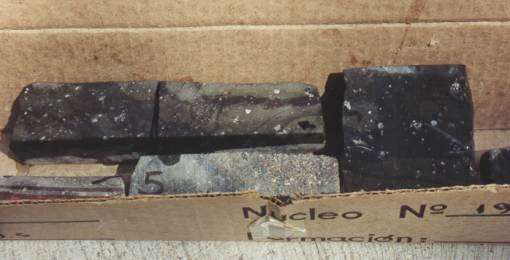
Unique "melt-rock" image (andesite)
from Y-6 (N19), Source: Homepage J. Smit
|
|

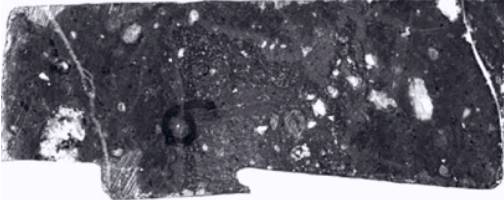
Another rare photos of andesite
from the borehole Y-6
|
|

Andesitic "glass" fragment (Claeys)
|
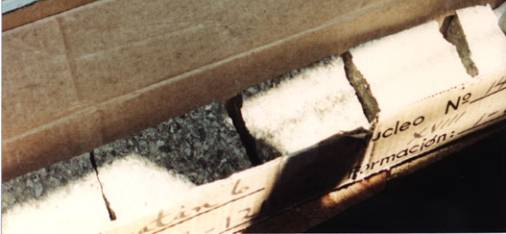
Breccia-rich melt from Y-6 (N-14)
with enclosed anhydrite
Source: Homepage J. Smit
|
|
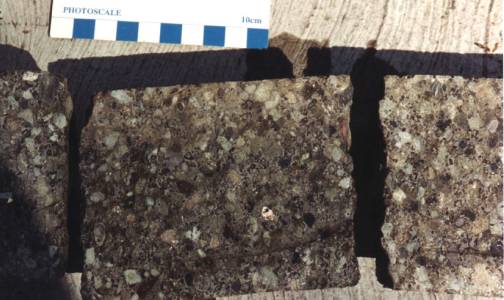
Breccia-rich melt from Y-6
(N-14), Source: Homepage J. Smit
|
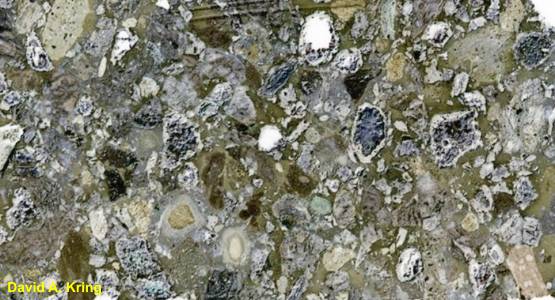
Y6 (N-14): Breccia-rich melt with
basement debris (such of granite, gneis and amphibolithe)
|
| |
|
Analysis of the Chicxulub-Andesite
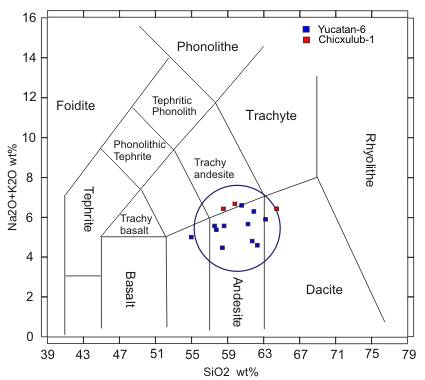
Diagram of the analyzed data
|
Analyzes of "andesitic melt" from PEMEX
boreholes
(Schuraytz et al., 1994 & Hildebrandt
et al., 1991, Swisher et al., 1992)
| |
Bohrung Yucatan-6
|
Chicxulub-1
|
|
|
N-17 |
N-19 |
N-10 |
"Andesite" |
|
SiO2 |
62.30 |
61.90 |
63.20 |
60.50 |
54.80 |
57.40 |
61.20 |
58.50 |
61.70 |
58.30 |
57.60 |
64.60 |
59.71-58.45 |
| Al2O3 |
14.60 |
13.10 |
12.60 |
13.60 |
15.30 |
16.41 |
14.70 |
15.50 |
13.70 |
13.70 |
15.50 |
14.90 |
15.84-13.77 |
| MgO |
2.90 |
3.20 |
3.10 |
3.20 |
3.15 |
2.96 |
2.74 |
2.75 |
2.55 |
2.92 |
3.05 |
2.75 |
5.42-4.06 |
| CaO |
8.80 |
10.40 |
10.20 |
10.50 |
11.90 |
10.18 |
9.30 |
10.55 |
10.01 |
12.10 |
11.41 |
5.50 |
11.24-9.35 |
|
Na2O |
2.10 |
4.40 |
4.00 |
4.70 |
3.25 |
3.10 |
2.75 |
3.41 |
2.54 |
3.41 |
3.62 |
3.71 |
4.60-4.01 |
|
K2O |
2.50 |
1.90 |
1.90 |
1.90 |
1.75 |
2.47 |
2.91 |
2.19 |
2.27 |
1.06 |
1.76 |
2.72 |
2.42-2.07 |
| FeO |
4.80 |
4.80 |
4.50 |
5.00 |
5.50 |
4.80 |
3.90 |
3.56 |
3.83 |
3.70 |
4.24 |
4.60 |
4.36-3.49 |
| TiO2 |
0.50 |
0.40 |
0.40 |
0.40 |
0.56 |
0.54 |
0.40 |
0.40 |
0.36 |
0.39 |
0.43 |
0.53 |
0.13 |
| MnO |
0.10 |
0.10 |
0.10 |
0.10 |
0.13 |
0.12 |
0.09 |
0.11 |
0.06 |
0.11 |
0.11 |
0.09 |
0.14 |
Weight fractions in %
Thin sections of andesite melt with grains of feldspar
and pyroxene
|

|

|

|

|

|
|
Y-6 N17
|
Y-6 N19
|
Y-6 N19
|
|

|

|

|
|
C-1 N9
|
C-1 N10
|
Thin sections of andesite melt
with grains of feldspar (plagioklase)
|
|
The observed "suevite" of borehole Yucatan-6 is clearly stratified
in terms of composition, grain size, type of matrix and concentration of melt
material. Three distinct types of "suevite" breccia can be identified:
- An upper "suevite"
(carbonate-rich). Small densely packed carbonate clasts clearly dominate
over crystalline basement fragments. The clasts are embedded in a porous,
10 micron-size matrix. This "suevite" represents a fall-back
material.
- A middle "suevite"
(clast-rich). The silicate basement clasts and altered silicate melt fragments
increase in proportion with depth. The clasts are suspended in a more compacted
and much less porous matrix.
- A lower "suevite"
(thermometamorphic). This is composed of basement and evaporite clasts and
abundant silicate melt fragments. The matrix is completely crystalline
and consists of euhedral feldspar and pyroxene grains.
The lower "suevite"
can be viewed as an intermediary unit between middle "suevite" and the underlying
the melt rocks, already described by Kring and Boynton (1992), Schuryatz et
al. (1994), and Warren et al. (1996). It appears to have reacted with the
underlying hot andesitic melt-rock matrix. Samples of melt clasts, glasses,
melt rocks and melt matrix separates were analyzed for major oxides (Sharpton
et al., 1992; Sigurdsson et al., 1991; Izett et al., 1990; Claeys et al.,
2003).
|

|
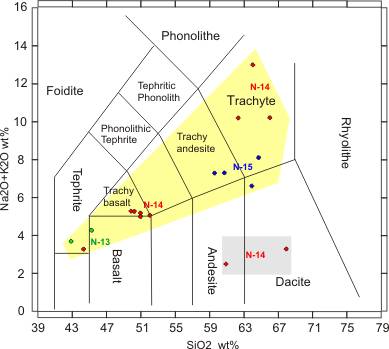
Spectrum of analyzed silicate melt
particles
|
|
Analyzes of silicate
melt particles (Yucatan-6)
(Claeys et al., 2003)
|
|
Upper "suevite"
|
Middle "suevite"
|
Lower "suevite"
|
|
|
N13 |
N13 |
N13 |
N14 |
N-14 (av) |
N-14 (min) |
N-14 (max) |
N14 |
N14 |
N14-5 |
N14-10 |
N14-11 |
N14-14 |
N14-15 |
N15 (av) |
N15 (min) |
N15 (max) |
N15-10 |
|
SiO2 |
42.8 |
45.2 |
32.7 |
44.3 |
64.7 |
63.9 |
66.0 |
67.9 |
60.9 |
52.00 |
50.90 |
50.9 |
50.2 |
49.8 |
62.3 |
60.7 |
64.0 |
59.6 |
|
Al2O3 |
9.8 |
9.5 |
7.7 |
14.1 |
18.1 |
17.7 |
18.8 |
16.9 |
16.6 |
11.2 |
11.0 |
11.7 |
11.1 |
11.0 |
16.6 |
15.8 |
17.4 |
13.1 |
|
MgO |
5.4 |
4.9 |
4.3 |
15.5 |
2.9 |
2.7 |
3.2 |
2.5 |
5.4 |
4.0 |
3.9 |
4.2 |
4.0 |
3.5 |
2.0 |
1.5 |
2.4 |
4.2 |
|
CaO |
16.2 |
17.0 |
25.7 |
3.1 |
2.7 |
2.6 |
3.0 |
1.7 |
1.9 |
12.0 |
12.5 |
11.5 |
13.1 |
13.5 |
3.2 |
2.5 |
3.9 |
7.7 |
|
Na2O |
2.4 |
2.5 |
2.1 |
2.6 |
6.5 |
6.0 |
7.3 |
0.6 |
0.9 |
3.4 |
3.3 |
3.5 |
3.6 |
3.6 |
4.6 |
3.2 |
5.4 |
5.1 |
|
K2O |
1.3 |
1.8 |
1.1 |
0.7 |
1.6 |
0.6 |
2.6 |
2.7 |
1.6 |
1.7 |
1.7 |
1.7 |
1.7 |
1.7 |
5.6 |
4.1 |
7.6 |
2.2 |
|
FeO |
4.1 |
4.0 |
2.9 |
13.2 |
3.9 |
3.5 |
4.6 |
5.2 |
9.1 |
4.3 |
4.4 |
4.7 |
4.4 |
3.9 |
5.5 |
4.7 |
6.00 |
5.2 |
|
TiO2 |
0.4 |
0.4 |
0.3 |
- |
1.2 |
1.2 |
1.2 |
0.7 |
1.0 |
0.4 |
0.4 |
0.5 |
0.5 |
0.4 |
- |
- |
- |
0.5 |
|
MnO
|
0.1 |
0.1 |
0.1 |
- |
- |
- |
- |
0.07 |
0.09 |
0.1 |
0.1 |
0.1 |
0.1 |
0.1 |
- |
- |
- |
0.1 |
Weight fractions in %
Note:
Chemically different silicate melt particles occur in all parts of
the "suevite". The amounts of SiO2, K2O and Na2O are variable
and not compatible with the andesitic melt below . These melt
fragments document a mixed melt at the contact of magma and bedrock.
Only two analyses show andesitic-dacitic composition.
|
|
1.2 UNAM
The UNAM drilling program
incorporated continuous coring in eight boreholes distributed within and immediately
outside the crater rim, with three boreholes (UNAM-5, UNAM-6, UNAM-7)
cutting the carbonate-"impact" breccia contact. The boreholes sampled the
"impact" breccias, with the carbonate-"impact" breccia contact lying at varying
depths between 222 and 332 m. "Impact" breccias are characterized by carbonate,
melt and crystalline basement clasts supported in a carbonate-rich or melt-rich
matrix. Two breccia units, have been cored, where upper breccias are rich
in carbonate clasts and lower breccias are rich in melt and basement clasts.
In the Santa Elena (U5) borehole the contact of "impact" breccias and Paleogene
carbonates lie at 332 m. The"Suevitic" breccias present a thickness
greater than 146 m. The basal carbonates up to 30 m above the "impact" breccias
contact are characterized by white creamy limestones, with several thin clay
layers and variable content of clay lenses.
"Impact" breccias
are characterized by carbonate, melt and crystalline basement clasts supported
in a carbonate-rich or melt-rich matrix. Two breccia units have been cored,
where upper breccias are rich in carbonate clasts and lower breccias are rich
in melt and basement clasts. Upper breccias have high magnetic susceptibilities,
low seismic velocities, low density and high porosities and permeabilities.
Lower breccias in contrast show low susceptibilities, variable high seismic
velocities and lower porosity and permeability.
|

|
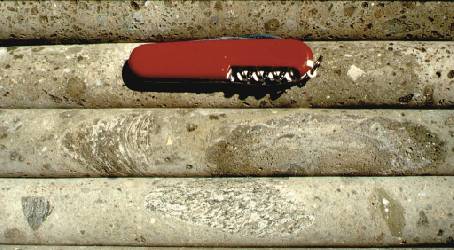
Source: Homepage J. Smit (2)
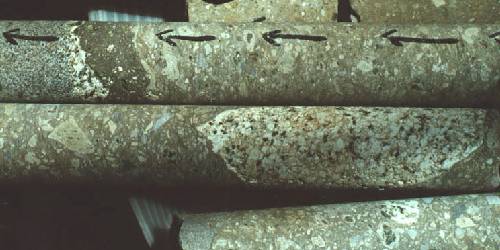
Breccias from UNAM-5 with crystalline
basement clast
|
1.3 CFE-UNAM
As part of the Comision
Federal de Electricidad (CFE) program, exploratory boreholes have been
drilled near Merida, Huhi and Valladolid.
The program includes three boreholes (BEM1, BEH1, BEV4) drilled
with continuous core recovery system, which allows investigation of the
stratigraphy in this zone.
Only the borehole Valladolid BEV-4 cored a 34 m thick section of
breccias between 250 to 284 m deep, which is part of the proximal
ejecta blanket deposits. Breccias are characterized by abundant clasts
of limestone, dolomite, gypsum and anhydrite.
|

|
1.4 CSDP (Yaxcopoil-1)
The Yaxcopoil-1 well,
drilled as part of the CSDP international project. Continuous coring recovered
cores from 404 m down to 1511 m of Paleogene sediments (400 m), "impactites"
(100 m) and Cretaceous carbonates (1000 m). The 100 m thick "impactite"
sequence is formed by six distinct units, which record variable conditions
of emplacement and "post-impact" alteration. The "impactite" sequence
in the Yaxcopoil-1 borehole was cored from 795 m to 895 m.
The section is formed by six distinct units. Subunits are characterized
by distinct textural and compositional differences in size, type and relative
abundance of clasts and melt-rich or carbonate-rich matrix types.
-
Upper Sorted
“Suevite” (795-808 m)
-
Lower Sorted
“Suevite” (808-823 m)
-
Upper “Suevite”
(823-846 m)
-
Middle “Suevite”
(846-861 m)
-
Brecciated
Melt Rock (861-885 m)
-
Lower “Suevite”
(885-895 m)
|

|
|

K/T-boundary
|

Upper sorted "suevite"
|

Lower sorted "suevite"
|

Upper "suevite"
|

Middle "suevite"
|

"Suevite" intruded melt
|

Lower "suevite"
|

K/"suevite"-boundary
|

Dyke "suevite"
|
| Source:
Homepage J.Smit |
|
|
|

|


|
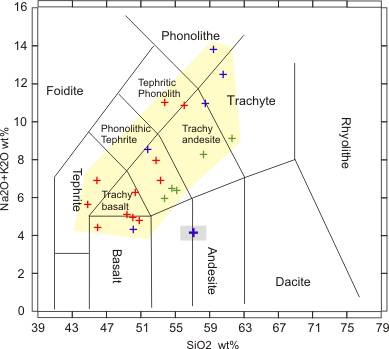
Spectrum of analyzed silicate melt
particles
|
|
Analyzes of silicate
melt particles (Yaxcopoil-1)
(Tuchscherer et al.,
2004)
| |
Upper "suevite"
|
Middle "suevite"
|
Brecciated melt rock
|
Lower "suevite"
|
|
|
n=20 |
n=14 |
n=33 |
n=25 |
n=16 |
n=20 |
|
SiO2
|
60.51 |
56.97 |
50.09 |
58.43 |
51.78 |
59.35 |
|
Al2O3
|
18.70 |
20.10 |
15.24 |
21.23 |
15.85 |
18.00 |
|
MgO
|
1.23 |
0.33 |
6.52 |
0.57 |
3.76 |
0.19 |
|
CaO
|
4.36 |
4.32 |
0.75 |
5.43 |
4.39 |
0.88 |
|
Na2O
|
1.31 |
2.34 |
0.47 |
3.87 |
1.47 |
1.18 |
|
K2O
|
11.17 |
1.76 |
3.83 |
7.10 |
7.05 |
12.66 |
|
FeO
|
1.05 |
4.23 |
5.19 |
1.67 |
2.43 |
5.05 |
|
TiO2
|
0.73 |
0.77 |
0.48 |
0.28 |
0.71 |
0.52 |
|
MnO
|
- |
0.03 |
0.01 |
- |
- |
0.03 |
(Hecht et al., 2004)
| |
Upper "suevite"
|
Middle "suevite"
|
Brecciated melt rock
|
Lower "suevite"
|
|
|
n=12 |
n=22 |
n=17 |
n=34 |
n=22 |
n=9 |
n=25 |
n=9 |
n=7 |
n=37 |
n=10 |
|
SiO2 |
50.80 |
50.07 |
45.92 |
52.78 |
44.82 |
50.39 |
49.42 |
45.95 |
53.30 |
53.81 |
56.08 |
| Al2O3 |
14.33 |
14.56 |
16.45 |
16.97 |
14.92 |
17.75 |
15.55 |
16.09 |
18.37 |
16.82 |
17.37 |
| MgO |
6.27 |
6.28 |
1.12 |
2.89 |
2.04 |
3.85 |
4.93 |
5.53 |
3.74 |
0.16 |
0.35 |
| CaO |
1.60 |
2.54 |
4.45 |
5.12 |
3.74 |
5.30 |
9.17 |
4.40 |
6.26 |
2.04 |
2.65 |
|
Na2O |
0.48 |
1.03 |
3.46 |
4.05 |
3.26 |
3.17 |
3.16 |
2.42 |
2.63 |
2.66 |
3.29 |
|
K2O |
4.32 |
3.92 |
3.47 |
3.92 |
2.36 |
3.08 |
1.93 |
1.98 |
4.29 |
8.35 |
7.51 |
| FeO |
7.11 |
6.77 |
4.99 |
1.95 |
4.63 |
3.95 |
3.74 |
3.75 |
3.03 |
0.81 |
0.99 |
| TiO2 |
0.62 |
0.63 |
0.56 |
0.50 |
0.39 |
0.19 |
0.46 |
0.37 |
0.09 |
0.22 |
0.21 |
|
MnO
|
0.01 |
0.01 |
0.02 |
0.01 |
0.01 |
0.02 |
0.04 |
0.02 |
0.02 |
- |
0.01 |
(Nelson et al., 2012)
| |
Upper "suevite" |
Middle "suevite |
Brecciated melt rock
|
|
SiO2
|
54.90 |
61.50 |
58.30 |
54.30 |
55.70 |
|
Al2O3
|
24.80 |
23.80 |
16.10 |
27.40 |
26.80 |
|
MgO
|
1.27 |
0.20 |
0.11 |
0.19 |
0.75 |
|
CaO
|
8.67 |
5.16 |
1.25 |
10.40 |
9.24 |
|
Na2O
|
4.96 |
5.74 |
4.90 |
4.94 |
6.18 |
|
K2O
|
1.54 |
3.38 |
3.36 |
1.04 |
0.96 |
|
FeO
|
1.13 |
0.68 |
0.57 |
1.24 |
1.77 |
Weight fractions in %
Note: Chemically
different silicate melt particles occur in all parts of the "suevite".
The amounts of SiO2, K2O and Na2O are variable and not compatible
with an andesitic melt. These melt fragments document a mixed melt of
magma and bedrock.
Some selected quotes:
|
Nelson et al. (Geochemica et Cosmochimica
Acta 86 (2012)
Unit 5: The hand samples from unit 5
contain melt clasts that are usually pink, brown, or green in colour,
amidst a dark brown or green matrix. Previous authors reported these
laths to be plagioclase, orthoclase, potassium feldspar, and rare
pyroxene (Dressler et al., 2004; Kring et al., 2004; Tuchscherer et
al., 2004a; Wittmann et al., 2004). Most of the laths consist of plagioclase
with consistent compositions between the rim and centre of the clasts.
In addition, near the rim of the melt clasts, the tabular laths are
often consistent with a potassium feldspar composition (adularia)
coincident with a general enrichment of K along these rims.
The clasts and matrix in samples from unit 5 have very different major
element signatures. Multiple generations of Mg-rich phyllosilicate
are present in the samples. In terms of weight percent abundances,
MgO concentrations in the matrix phyllosilicate range from 15 to 30
wt.%. In contrast, the melt clasts contain 0–5 wt.% MgO. MgO and Al2O3
are spatially decoupled, as Al2O3 has a range of about 15–25 wt.%
and is concentrated in melt clasts. The matrix, in contrast, contains
Al2O3 concentrations ranging from below detection limit to 11 wt.%.
Melt clasts in unit 5 contain a large range of SiO2 concentrations,
from about 54 to 66 wt.%, whereas the matrix contains 37–50 wt.% based
on point analyses. There is an enrichment of K2O on most of the edges
of the melt clasts forming an enriched rim typically 50–100 and sometimes
up to 400 µm. In addition, the rims of both the large melt clasts
and the small melt particles floating in the matrix contain or are
covered with laths of K2O-rich adularia. The Mg-rich matrix material
itself is very poor in K2O, often containing K2O values below detection
limits. However, FeO is enriched in the matrix compared to the melt
clasts.
|

Yax-1: 864 m (BMR)
|
Kring et al. (Meteoritics
& Planetary Science 39, Nr 6, 2004)
Unit 3 (US)
This 23 m-thick melt-rich unit of breccias is dominated by fragments
of altered silicate melt, generally with microcrystalline textures.
Although some fragments appear to have been partly to wholly glassy
before being replaced by phyllosilicates and calcite. Primary minerals
in the microcrystalline melts include pyroxene, plagioclase and alkali
feldspar. Some of these silicate melts contained immiscible carbonate
melt, gas vesicles (some of which were subsequently filled with secondary
calcite and silicates), and flow-aligned crystals. In general, these
melt fragments are more vesicular than those in the overlying suevitic
units. The melt fragments in this breccia section entrained feldspar,
quartz, magnetite, lithic metaquartzites, micritic carbonate, shale,
and crystalline mafics.
The textural distinction between solidified silicate melt with immiscible
carbonate melt and solidified silicate melt with gas vesicles subsequently
filled with calcite is subtle. Ellipsoids of carbonate protruding
from the edges of silicate melt fragments into the breccia matrix
indicate that the carbonate was solid before the fragmentation of
the melt fragment and incorporation into the breccia. In this case,
the carbonate is a primary phase and was immiscible when the melts
were molten. Ellipsoids of carbonate completely bounded by silicate
melt could also represent immiscible carbonate melt but, in these
cases, could instead be ellipsoids of secondary carbonate filling
gas-evacuated vesicles."
Unit 4 (MS)
A 15 m-thick breccia was logged immediately above the green melt unit
with abundant and sometimes very large (up to 20 cm) clasts of banded
melts. The melt is dominated by microcrystalline, pyroxene, plagioclase,
and alkali feldspar. Similar to the green melt, although the color
(shades of rose) is different. The melt entrained small amounts of
shocked and unshocked clasts of quartz, feldspar, sandstone, metaquartzite,
and granite. These melt fragments exist in a breccia that is variously
clast and matrix supported, the latter of which appears to have been
a conduit for fluids and is now charged with secondary alkali feldspar
and subordinate carbonate.
Unit 5 (BMR)
"The green melt is generally massive in appearance, but contains flow
lines on both macroscopic and microscopic scales that are suggestive
of incompletely mixed and rapidly quenched melt. No fresh glasses
were observed. The melt is dominated by microcrystalline, Ca-rich
pyroxene, plagioclase and alkali feldspar. Granitic clasts up to 4.5
cm and mafic clasts up to 6.5 cm were observed. In thin section, small
amounts of shocked and unshocked clasts are entrained in the melt,
including quartz and quartzite with planar deformation features and
ballen structures after cristobalite, isolated altered feldspar and
mafic minerals, and mafic lithics. Inclusions within the thin section
are aligned, as in a trachytic texture, implying that the melt
was flowing before solidification. The green melt is also brecciated
and highly altered along its margins where the contacts were conduits
for carbonate-rich fluids. While the core was being recovered, a 10
m-thick carbonate-charged and brecciated green impact melt unit (unit
6) with larger clasts, including a 34 cm granite, was logged below
the principal 24 m-thick green melt unit (unit 5). |
|

|

Compositions of pyroxene and feldspar in the
groundmass of the Yax-1 green melt (unit 5) compared to similar compositions
in the Yucatan-6.
The unit 5 samples are Yax-1 (861.4 and 863.5 mbsf). The Yucatan-6 sample
is Y6N17.
Left: Yax-1; Ballen quartz within
the pyroxene and plagioclase groundmass of the green andesitic melt
|
| |
Hecht et al. (Meteoritics
& Planetary Science 39, Nr 7 (2004)
Types of Melt Particles
"Type 1 melt particles are brownish to pale green and lack any
primary crystallization, except remnants of devitrification spherulites.
The shape of these fragments is subrounded in most cases and rarely angular.
Some large vesicles can occur, and particle margins may display porosity
at the micrometer scale, both indicating degassing during cooling of the
melt. Melt particles of type 1 have only been observed in samples from
the upper three suevite units with a rough trend of decreasing frequency
from top to bottom.
Type 2 melt particles are also pale green to brownish in color
and may contain abundant vesicles, up to about 30 vol%. Smaller particles
frequently exhibit angular shard-like shapes that probably formed due
to broken-up vesicles. Some plagioclase microphenocrysts occur, in contrast
to melt particles of type 1. Rims of melt particle shards are frequently
enriched in plagioclase microphenocrysts. Similar to type 1, the melt
particles of type 2 were only observed in the upper three suevite units.
Type 3 melt particles are the most common in all suevite units,
except in unit 1, where type 1 and 2 dominate. Type 3 melt particles are
greenish to brown-beige colors and display sizes up to several cm. They
comprise a variety of shapes in units 2 to 4, including uniform sub-rounded,
elongated, lumpy, elongated, and twisted forms, and more angular forms
in units 5 and 6. Type 3 melt particles are moderately to nearly completely
crystallized with plagioclase and clinopyroxene laths, commonly displaying
flow textures. An increase in the degree of crystallization with depth
is evident from the samples of suevite units 2 to 4. Within units 4, 5,
and 6, melt particles of type 3 are generally well crystallized (but aphanitic).
Clinopyroxene is abundant in melt particles at the lowest two units of
the suevitic sequence. In units 2 to 4, microphenocrysts of clinopyroxene
were only observed as inclusions within patches of secondary K-feldspar
in type 3 melt particles.
Type 4 melt particles are dark brown to nearly opaque, subrounded
to subangular in shape, and always display an aphanitic texture. They
are generally rich in clasts of silicate or carbonate minerals (mostly
quartz, feldspar, and calcite."
Melt particles
"With some exceptions, most melt particles display SiO2 contents between
57 and 63 wt%, which represents the typical range of andesites.
Many of the other major element contents of the melt particles exhibit
a wide range. These include the alkalies that are very sensitive to hydrothermal
alteration. Therefore, any rock classification based on these elements
has to be performed with caution. For example, the extension of melt particle
compositions from the andesite field toward the trachyandesite and trachyte
field can be attributed to potassium enrichment during hydrothermal alteration.
Most melt particles exhibit relatively high Al2O3 and MgO contents compared
to the continental crust and average impact melt rocks.
The type 1 and 2 melt particles follow a similar
compositional trend that is different from type 3 and 4 particles. Type
1 and 2 are significantly depleted in CaO and Na2O compared to the average
continental crust and (impact) melts from Chicxulub and other large craters
world-wide. Furthermore, type 1 and 2 melt particles display a rather
wide range in FeO und K2O contents with a distinct trend of FeO and K2O
enrichment with SiO2 and Al2O3 depletion.
The melt particles of type 3 show the largest variation in chemical composition,
which is related to the degree of primary crystallization (plagioclase
and clinopyroxene) and the intensity of hydrothermal alteration. Particles
in the upper suevite units, that only contain a few plagioclase microphenocrysts,
have low CaO and Na2O and elevated FeO and MgO contents similar to those
of type 1 and 2 particles. Particles with abundant clinopyroxene microphenocrysts
have the highest CaO contents.
These melt particles are closest in composition to CaO-rich samples of
the (impact) melt rocks derived from the Y-6 drill site with the exception
of MgO, which is much higher in melt particles from Yax-1.
On average, K2O is enriched in melt particle type 3 compared to the continental
crust and average (impact) melt rock, although patches of secondary Kfeldspar
were not included in the microprobe analyses of melt particles, where
they could be avoided. Melt particles of the lower suevite (unit 6) are
pervasively altered by K-feldspar. In this case, secondary K-feldspar
could not be avoided from the chemical analysis, which is evident from
their high K2O contents. Most of the melt particles of type 3 have much
higher MgO, and slightly lower FeO contents.
Compositions of the dark aphanitic melt particles (type 4) are closest
to the average continental crust and average (impact) melt rock, although
Al2O3 is enriched and SiO2 is depleted in comparison. Most particles of
type 4 are andesitic and very similar in composition. One particle has
a higher SiO2 content and resembles a dacite in composition, although
the FeO, MgO, and TiO2 contents are rather high for a typical dacite.
Two particles plot in the trachyandesite field; however, some secondary
potassium enrichment can not be excluded."
Primary Composition of Impact Melts
"The determination of the primary impact melt composition is rather problematic
in an environment in which significant post-impact hydrothermal alteration
has occured.
Since hydrothermal mass transfer was shown to be important in those melt
particles that were least crystallized before the onset of post-event
alteration, we focus on the best crystallized melt particles of type 3
and on dark aphanitic melt particles (type 4), which show the least evidence
of any alteration.
Most of the least-altered melt particles are andesitic in composition.
One melt particle of type 4 possesses a higher dacitic SiO2 content, indicating
that more acidic target (?) lithologies may locally be involved and were
not homogenized to the bulk andesitic impact melt. The compositional range
of the (impact) melt particles is consistent with previous studies on
(impact) melts at Y-6 and C-1. The melt particles of type 3 with a high
modal amount of clinopyroxene and relatively high CaO and low SiO2 contents,
similar to those found at Y- 6, might suggest the presence of mafic lithologies
in the target (?) rocks, e.g., basalts or basaltic andesites. Contribution
of a mafic precursor component was proposed for the Chicxulub impact melt
by Kettrup et al. (2000) and for Chicxulub-related spherules by Schulte
et al. (2003). However, petrological studies on the Ca-rich impact melt
rocks at Y-6 demonstrate that a possible contribution of mafic rocks (diabases,
pyroxenites, or amphibolites) must have been limited (Kring and Boynton
1992). We propose that the elevated CaO (and MgO) contents and reduced
SiO2 contents in the melt that characterize these clinopyroxene-rich particles
result from the mixing of the silicate basement rocks with the overlying
carbonate sequences."
|
|
2. My opinion to the origin of the Chicxulub structure
The whole debate about the genesis of
drilled melt and breccias in the Chicxulub crater is conducted with
wrong assumptions. The Chicxulub "impact" crater is in fact the
caldera of a supervolcano that is created by a huge overpressure explosion.
The volcanic origin is by drilled pure andesite in the center of
the structure no doubt proved. The bedrock was blasted in a great extent
and widely distributed.
Gravimetric
investigations on Yucatan, suggest that the former magma chamber is not
limited under the center of the Chicxulub crater. Possibly the dioritic
magma chamber reach far to south. It is possible that the crater to south
is open (no boreholes). That would be one explanation for the thick breccia
units in Guatemala and South-Mexico.
The ascending
andesitic melt in the center of the explosion had only a low eruptive
potential. There is no evidence of eruptive melt in the breccias outside
the crater on the Yucatan peninsula (questionable Y-5A). The caldera after
the explosion was immediately covered with falling-back debris. The detection
of dykes or veins in the bedrock (Ya-1) indicates lateral intrusions from
the yet not cooled andesitic melt body (mixed with breccia). In two wells
(C-1, Y-1) were found "ash with glass" in depths between 1300 and 1400
m. This is mysterious and would be worth a new analysis.
There are two different types of breccias from the ruined bedrock. There
are breccias above the intact bedrock and breccia above the igneous andesite.
The breccias above the bedrock has no contact with the melt and are unchanged.
The breccias above the andesite (S-1, C-1, Y-1 wells) are melted or are
in contact with melt, in decreasing intensity upwards. Possibly the lowest
parts of falling-back debris are already fallen in the andesitic melt.
A sorting the breccias (called units) make not sense because convective
movements in the melt are expected. In the upper part of the breccia-package
are smaller components of falling-back debris concentrated and have already
stratification. Glass fragments in the melted breccias-package are geochemically
different. These fragments belong as the breccia to the falling-back debris
after the explosion. Presumably, these glasses come from a mixed melt
of igneous andesite and bedrock on top of the eruptive vent. All the others
in Central America found glassy spherules and glass fragments have probably
not a connection with the Chicxulub event (see below).
The occurrence of shock-generated features is not only an indicator for
an impact event, because this is also proved by finds in volcanic structures.Very
exceptional shock structures, that caused by volcanic shock waves, can
you here seen: "Mysterious
columnar sandstone"
|
B. The Chicxulub K/T-boundary
debate
My opinion to the debate
PEMEX investigators of the l970’s (Meyerhoff
et al and Lopez-Ramos) reported limestones with diverse planktic foraminiferal
assemblages of upper Maastrichtian age overlying the breccia in wells
Chicxulub-1 and Yucatan-6. An interval of 18 m-thick Maastrichtian marls overlying
the "impact" breccia at the C-1 well. It was identified the planktic foraminiferal
species Globotruncana rosetta, G. ventricosa, G. lapparenti, G. fornicata,
Pseudoguembelina excolata, Heterohelix globocarinata, Pseudotextularia elegans,
Planoglobulina carseyae, and Globigerinelloides volutus in this
interval and conclude that the Chicxulub event occurred before the K/T-boundary.
By Keller et al (2004) in Yaxcopoil-1, unit 794.60-794.11m,
detected Maastrichtian foraminifera are unfortunately dolomitic crystallized
and give rise to discussion. Smit interpret these forms as dolomite
rhombs.
Nevertheless, the conclusions of Keller et al. are right, and the Chicxulub
event has nothing to do with the K/T-boundary. The K/T-boundary is biostratigraphically
in profile clearly placed 0.50 cm above the breccias. The discussed sediments
in the unit above the breccia are no catastrophic or hardground deposits (in
sense Smit), they in contrary are layered in a normal marine milieu
with moderatly movements during a longer period of time (300 000 years). A
portion of the sediments shows millimeter fine laminations. This indicates
slightly increased water-energy for the deposition of sediments. Moreover,
in the sediments was bioturbation detected. It is also normal that at the
beginning various reworked material of limestone and dolomite debris was deposited
mainly. Striking are inserted thin layers of green clay (or glauconite) indicate
altered sedimentation conditions. The last "green clay" layer (794.12m) is
markedly and could be the equivalent of the "Boundary Tone". The bubblelike
inclusions in the greenish layer could be spherules from the widespread post-Chicxulub
volcanism. A significant time gap is possible because the following marine
sediments suddenly documented a changed marine milieu.
The conclusions by Arz et al. (2004) for
the Yaxcopoil-1 unit 794.60-794.11m are not right. They confirmed unintentionally
the thesis of Keller el al., because the detected Cretaceous foraminifera
are not reworked. They are in good condition. A reworking during
the postulated catastrophic crater infilling (where are breccias) would have
destroyed these filigree casings. Furthermore, how it should be possible these
originally in the limestone embedded casing undamaged to isolate after a short
time. The postulated mixed reworking assemblage of foraminifers (Albian-Turonian
and Campanian-Maastrichtian) should be evaluated with caution. There are also
long-lived Cretaceous species therein.
........
more here
C. The distribution and significance of spherules-layers in Central America
The many
layers with glassy spherules in outcrops of Central America -- which include
the time of Late Cretaceous, the K/T-boundary and youngest Tertiary -- are
a particular problem. A correlation is difficult and probably not useful to
find the biostratigraphic K/T-boundary. The equivalent of "Boundary Tone"
that marks the K/T transition, is with such spherules layers possibly not
to find. This can only succeed with support of the biostratigraphy and that
was due to the particular facies (fine clastic sediments) or a gap in the
sedimentation not been convincingly possible
*).
In many outcrops in Mexico, Guatemala, Belize and Haiti are spherules-layers
from the late Maastrichtian (zone CF1) and the Danian (zone P1a) documented,
and an attempt at a correlation has been subjected. A summary of the results
presented Gerta Keller et al. in several publications. It is striking that
the geochemical composition of the spherules varies, what is missing is a
plausible explanation.
*) The special fine clastic sediments of Mimbral
and Penon (no determinable fossils) at the transition between the Cretaceous
and Tertiary are controversial interpreted as Tsunami deposits (Smit et al.)
or as normal marine sedimentation (Keller et al.) after the Chicxulub event.
Depending on, this sequence between the zones CF1 and P1a would be for the
time insignificant or significant (300 000 years).
|

Outcrops with spherules layer, but
without breccias in Mexico
|

Outcrops with breccias and/or spherules
layer on Yucatan
|
The spherules
in recurrent strata -- from late Maastrichtian (zone CF1) until early Paleocene
(zone P1a) -- are registert as reworking of older layers of zone CF1 (eg Mendez
marl). The lower layers with spherules should be derived from the Chicxulub
event, the others should contain reworked spherules of lower layers. But that
should be doubted, it is easy to explain everything with "reworking". The
spherules layers fit well into an ongoing scenario of volcanic activities
in the region, was possibly was only accompanied by
the Chicxulub event and was steadily present until the early Paleocene. This
includes recurrent Iridium-anomalies, that never indicate impact events. The
Ir-peaks documented maxima in an ongoing volcanic scenario. The layers with
glassy spherules are both stratigraphically and geochemically very unevenly
distributed and should not be assigned to a single event. A connection with
the Chicxulub event can mandatory not be detected. A more regional volcanism
should be considered. The suspected volcanic scenario also includes the lapilli
or ash from Guayal in other outcrops.
The few relevant
geochemical analyzes of spherules in Central America documented regional differences.
The Danian spherules of Beloc (Haiti) correspond to an andesitic magma. K-rich
spherules from layers of Sierrita (Mexico) correspond to a phonolitic magma,
but the most of them can not be allocated due to their low SiO2% contents.
Spherules of Mimbral (Mexico) are different: Andesitic-dacitic and basaltic-trachybasaltic.
Spherules in the Brazos (Texas) outcrops correspond with a basaltic magma.
|

El Mimbral: Chaotic spherules layers
in Mendez marl
|
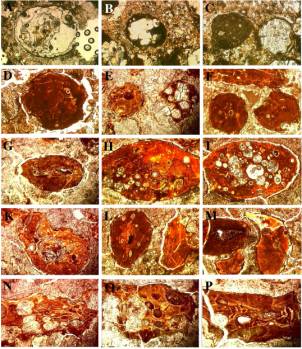
El Penon spherules
|
|
Selection of geochemical
analyzes of spherules
|
|
Brazos (Texas)
|
Mimbral (Mexiko)
|
Sieritta (Mexiko)
|
Beloc (Haiti)
|
|
Keller et al
|
Smit et al 1992
|
Schulte et al 2006
|
Sigurdson et al 1991
|
Izett et al 1990
|
Stueben et al 2002
|
|
|
Yellow
layer |
(n=250) |
(n=250) |
|
|
Ca-rich |
(n=21) |
(n=12) |
(n=61) |
min |
max |
(n=11) |
min |
max |
dark |
yellow |
Smectite |
Smectite |
|
SiO2 |
47.67 |
50.13 |
51.10 |
62.99 |
66.20 |
52.20 |
50.23 |
50.12 |
63.09 |
60.30 |
67.90 |
63.30 |
60.30 |
67.60 |
66.85 |
60.47 |
61.98 |
65.26 |
| Al2O3 |
10.28 |
12.73 |
19.63 |
15.73 |
18.73 |
12.40 |
29.15 |
29.55 |
15.21 |
13.70 |
15.30 |
14.40 |
13.70 |
15.30 |
14.94 |
14.21 |
9.82 |
11.12 |
| MgO |
3.52 |
4.18 |
3.23 |
3.01 |
2.64 |
3.90 |
2.35 |
2.14 |
2.74 |
2.20 |
3.80 |
2.80 |
2.40 |
3.80 |
2.75 |
3.16 |
3.92 |
4.64 |
| CaO |
1.34 |
1.70 |
3.35 |
6.88 |
0.84 |
22.96 |
0.57 |
0.56 |
7.26 |
4.50 |
10.90 |
7.10 |
4.70 |
10.90 |
5.38 |
11.45 |
1.06 |
0.88 |
|
Na2O |
0.08 |
0.09 |
0.11 |
3.34 |
0.84 |
2.02 |
0.10 |
0.10 |
3.63 |
2.40 |
3.70 |
3.30 |
2.40 |
3.60 |
1.96 |
2.78 |
0.05 |
0.06 |
|
K2O |
4.51 |
4.89 |
0.45 |
1.50 |
3.68 |
0.58 |
7.25 |
7.14 |
1.59 |
1.00 |
1.80 |
1.50 |
1.00 |
1.80 |
1.53 |
1.40 |
1.13 |
1.10 |
| FeO |
18.07 |
15.55 |
2.40 |
5.32 |
5.67 |
4.23 |
1.88 |
1.49 |
5.44 |
4.60 |
5.70 |
5.30 |
4.70 |
5.70 |
5.31 |
5.37 |
5.07 |
4.81 |
| TiO2 |
0.08 |
0.11 |
0.38 |
0.70 |
0.02 |
0.56 |
0.19 |
0.15 |
0.67 |
0.48 |
0.84 |
0.80 |
0.70 |
0.80 |
0.55 |
0.65 |
0.81 |
0.34 |
| MnO |
0.02 |
0.02 |
0.02 |
0.13 |
0.00 |
0.14 |
- |
- |
0.14 |
0.00 |
0.18 |
0.20 |
0.10 |
0.20 |
- |
- |
- |
- |
Weight fractions in %
|
|
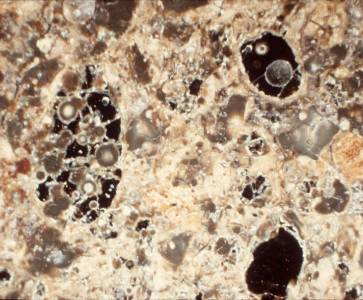
Danian Beloc glass
|
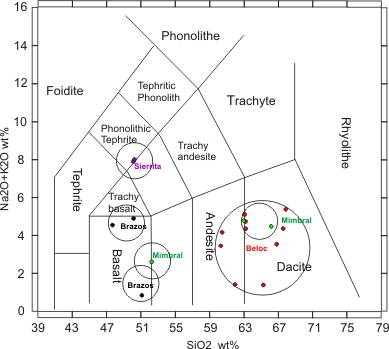
Beloc glass and others
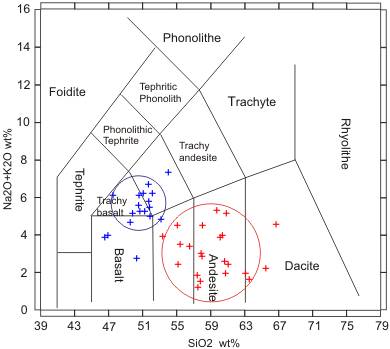
Two different varieties of Mimbral
glass (Bell & Sharpton, 1996)
|
|
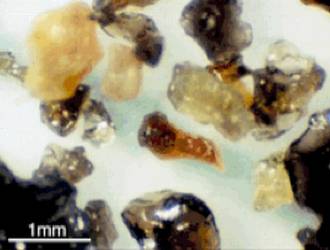
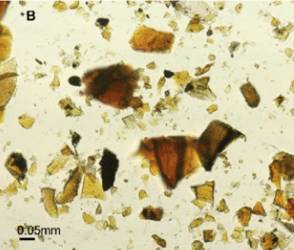
Mimbral glass
|
|
D. What suggest the spherules-bearing layer below the breccia-unit in
the Albion Island quarry (Belize)
"The Cretaceous-Tertiary boundary stratigraphy in north (Albion) and central
(Armenia) Belize encompasses the Maastrichtian dolomite and overlying
diamictite layer with basal spheroid bed. The northern Albion spheroid-bearing
clay layer rests directly upon Maastrichtian dolostones and consists
of brown to rust-colored clay, which is locally rich in oblate, pebble-size
dolomitic spheroids. Near the bed base, it is rich in irregular red or
green clay clasts. This whole clay layer ranges from 15 to 150cm thick.
The basal contact is sharp and is usually marked by a paper-thin hematitic
rind on the underlying Maastrictian dolostone. The spheroid-bearing clay
layer is highly deformed. Studies of associated red and green clay clasts
suggest that they are glass fragments that have been altered. This green
clay clasts (clay spheroids) are smectites.
The diamictite unit rests directly
upon the spheroid-bearing clay layer and consists of light tan, moderately
indurated and matrix-rich, poorly sorted breccia. The diamictite unit
contains at least 5 individual beds. Each of these beds ranges from 2
to 7 meters thick. Within individual beds, crude grading (with floating
boulder clasts near or at the top of beds) is common. As part of
the crude grading, boulders located at the base of some beds show imbrication
and clast support. Other internal structures are crude flow laminations,
which are located in the upper one to 2 meters of each bed. Some beds
have rare megaboulders near their bases or tops. Other beds contain
rare matrix-coated boulders up to 3 m in diameter. Diamictite matrix is
mainly highly comminuted dolomite in the silt-clay size range. Matrix
content commonly equals approximately 50 to 70 percent of the rock and
matrix is more abundant near the tops of most beds. This matrix contains
some red and green clay clasts, similar to those found within the underlying
spheroid-bearing clay layer. These clay clasts are thought to have a similar
origin to the ones mentioned earlier from within the spheroid-bearing
clay layer. Red and green clay clasts are much more common in the lower
2 to 3 meters of the diamictite unit matrix. Comparison of underlying
Maastrichtian dolomitic facies and lithologies of diamictite clasts shows
significant differences."
Source: Homepage D. King
|

Albion Island quarry
|

Albion spheroid-bearing
layer
|

dito
|

Spheroid bed
|

Dolomite spheroid (lapilli)
|

Boulder
|

"Diamictite"
unit Albion
|

Boulder
|
|
"Belize
has figured prominently in the Cretaceous-Tertiary boundary controversy
as a result of the discovery of clay spheroids and diamictite
in the Albion Island and Armenia outcrops.
In the Albion Island quarry the spheroid layer overlies Maastrichtian
dolomite and is between 1 and 2 m thick with some bedding features. This
layer is characterized by abundant rounded to subangular bodies (or clasts)
of dolomite and clay up to 2 cm in diameter, which float in a fine-grained
matrix of friable dolomite and calcite-silt. The diamictite above the
spheroid layer contains rounded to angular carbonate clasts in clay matrix
with some relic glass preserved. The spheroids and diamictite layers have
been interpreted as altered impact glass based on their smectite-rich
clay composition. There are significant differences in the clay mineral
compositions of the Maastrichtian dolomite, spheroid and diamictite units.
The spheroid clay layer is characterized by a single clay mineral phase,
which consists of extremely well-crystallized smectite characterized by
very high intensity, and a webby morphology with the major element a typical
Cheto Mg-smectite (Si, Al, Mg, with minor Fe and K). This Cheto
type Mg-smectite indicates a single origin for the spheroid layer and
the alteration of glass.
In the diamictite above the spheroid layer, the clay composition is similar,
with extremely abundant smectite (90%), but contains also minor amounts
of palygorskite, kaolinite and illite. Smectite is slightly less well
crystallized. These features suggest a multiple origin for the diamictite
constituents, including erosion of carbonate sediments, soils and glass
alteration."
Source: Keller et al. (Journal of the Geological Society,
160, 2003)
|
Geochemical analyzes
of Albion spherules by Pope et al. (1999)
|
|
Spheroid layer
|
Diamictite layer
|
|
|
n=12 |
max |
min |
n=11 |
max |
min |
|
SiO2
|
58.21 |
59.85 |
56.58 |
57.33 |
58.48 |
56.18 |
|
Al2O3
|
16.70 |
17.28 |
16.12 |
16.42 |
16.76 |
16.08 |
|
MgO
|
9.65 |
10.01 |
9.29 |
8.56 |
8.82 |
8.30 |
|
CaO
|
0.13 |
0.24 |
0.02 |
0.13 |
0.15 |
0.11 |
|
Na2O
|
0.06 |
0.07 |
0.05 |
0.06 |
0.08 |
0.04 |
|
K2O
|
0.36 |
0.40 |
0.32 |
2.00 |
2.53 |
1.47 |
|
FeO
|
3.43 |
3.68 |
3.18 |
6.02 |
7.06 |
4.98 |
|
TiO2
|
0.65 |
1.22 |
0.08 |
0.93 |
1.32 |
0.54 |
|
MnO
|
0.02 |
0.03 |
0.01 |
0.01 |
0.02 |
0.00 |
Weight fractions in %
|
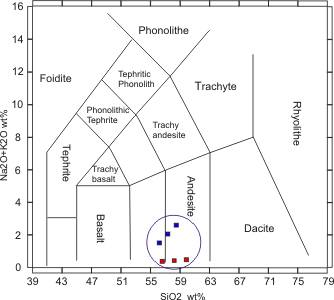
|
My opinion
The spheroid-bearing clay layer (smectite)
in the Albion Island quarry (northern Belize), immediately above the
eroded Maastrichtian bedrock, are older altered volcanic deposits,
and include a time gap to the following Chicxulub event.
The clay spheroids are altered volcanic
glass, and the dolomite spheroids are accretionary lapilli. The overlying
>15-m-thick diamictite are falling-back material from the Chicxulub
event. The breccias unit containing rare altered glass, large accretionary
blocks, striated, and impacted cobbles. The localities in Belize are
unique because here is documented a volcanic activity before the Chicxulub
event (right).
In southern Belize, these deposits are completely missing.
Here are directly above the bedrock, with a time gap, deposits of
the Paleocene, which are interspersed with reworked breccias (Cayo
diamictite), other clasts and volcanic glasses. This is the result
of a widespread volcanism at that time in the entire Caribbean region.
The situation is similar in the location Beloc/Haiti. About eroded
Maastrichtian limestones follow on a time gap deposits of the Paleocene,
which are interspersed with volcanic glasses.
The partly massive breccia packages of Guatemala and southern
Mexico (Actela, Trinitaria, Bochil, Guayal, Campeche drilling field)
again are falling-back debris from the Chicxulub event. It seems that
the whole region was in time of the Chicxulub event in a non-marine
phase. The biostratigraphically documented Paleocene sedimetation
follows after a time gap.
In Central Mexico a widespread volcanism
is noted in the Maastrichian period that started before the Chicxulub
event and has continued even after the event. Analyzes of glasses
documenting different volcanic origins. The thesis of reworked spherules
should be discarded.
The spheroid-bearing layer in the Albion Island quarry could
be the "missing link" for all older spherules-layers in Central America.
Here is my suggestion:
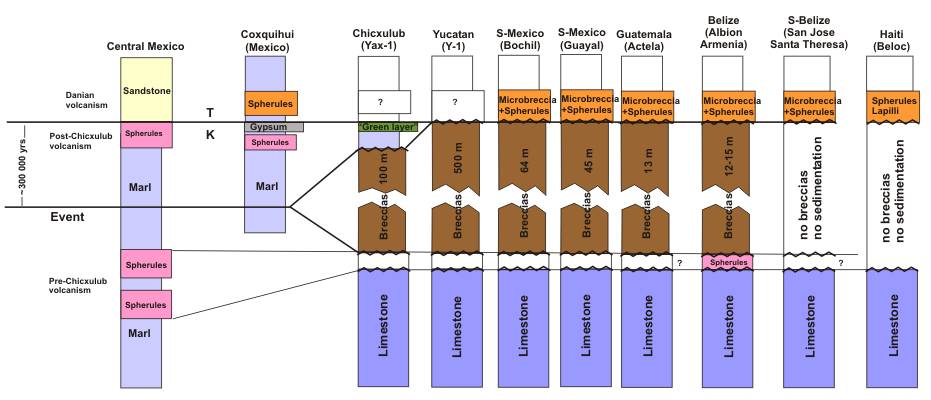
|

Alvaro Obregon, Belize

Albion, Belize

Spheroid bed, Belize

Spheroid beds, Haiti

Spheroid beds, Mexico
|
|

Thickness of Chicxulub
ejection breccias
|
|
|
|
E. Some sources
Homepage Gerta Keller
Homepage David King
Homepage Jan Smit
Arz et al. (2004) -- Foraminiferal biostratigraphy and paleoenvironmental
reconstruction at the Yaxcopoil-1 drill hole, Chicxulub crater, Yucatán Peninsula.
Meteoritics & Planetary Science 39(7), 1099–1111.
Claeys et al. 2003 -- The Suevite of drill hole Yucatan 6 in the
Chicxulub impact crater. Meteoritics & Planetary Science 38(9), 1299-1317.
Claeys et al.
-- The two different melt rocks of the Chicxulub impact crater and .......
Lunar and Planetary Science, XXIX. [1361.pdf]
Hildebrand et al. (1991) -- Chicxulub crater: a possible Cretaceous/Tertiary
boundary impact crater on the Yucatan Peninsula, Mexico. Geology 19, 867-871.
Hecht et al. (2004) -- Composition of impact melt particles and the effects
of post-impact alteration in suevitic rocks at the Yaxcopoil-1 ........
Meteoritics & Planetary Science 39, Nr 7, 1169–1186
Keller et al. (2003) -- Spherule deposits in Cretaceous–Tertiary boundary
sediments in Belize and Guatemala. Journal of the Geological Society, 160,
783–795.
Keller et al. (2003) -- Multiple impacts across the Cretaceous–Tertiary
boundary. Earth-Science Review, 62, 3-4, 327-363.
Keller et al. (2004) -- More evidence that the Chicxulub impact predates
the K/T mass extinction. Meteoritics & Planetary Science 39(7), 1127-1144.
Keller, G. (2012) -- The Cretaceous-Tertiary mass extinction,
Chicxulub impact, and Deccan volcanism. Earth and Life, International Year
of Planet Earth, 759.
Kring et al. (2004) -- Impact lithologies and their emplacement in the
Chicxulub impact crater: Initialresults from the Chicxulub Scientific Drilling
Project, Yaxcopoil, Mexico. Meteoritics & Planetary Science 39(6), 879-897.
Nelson et al. (2012) -- Petrographic investigation
of melt and matrix relationships in Chicxulub crater Yaxcopoil-1 brecciated
melt rock and melt rock-bearing suevite (846–885 m, units 4 and 5). Geochemica
et Cosmochimica Acta 86, 1-20.
Pope et al. (1999) -- Chicxulub impact ejecta from Albion Island,
Belize. Earth and Planetary Science, 170, 4, 351–364.
Schuraytz et al. (1994) -- Petrology ot impact-melt rocks at the Chicxulub
multiring basin, Yucatan, Mexico. Geology, vol 22.
Sharpton et al. (1993) -- Chicxulub multiring impact basin: Size and other
characteristics derived from gravity analysis. Science 261, 1564-1567.
Smit et al. (2004) -- Is the transition impact to post-impact rock
complete? Meteoritics & Planetary Science 39(7), 1113-1126.
Stinnesbeck et al. (2004) -- Yaxcopoil-1 and the Chicxulub impact.
Geologische Rundschau, 93, 10423-1065.
Tuchscherer et al. (2004) -- First petrographic results on impactites
from the Yaxcopoil-1 borehole, Chicxulub structure, Mexico. Meteoritics
& Planetary Science 39, Nr 6, 899–930.
Urrutia-Fucugauchi et al. (2011) -- The chicxulub multi-ring
impact crater, Yucatan carbonate platform, Gulf of Mexico. Geofisica
International, 50-1, 99-127.
Warren et al. (1996) -- Mega-impact
melt petrology (Chicxulub, Sudbury, and the Moon. Geological Society of
America, Special Paper 307
|


































































